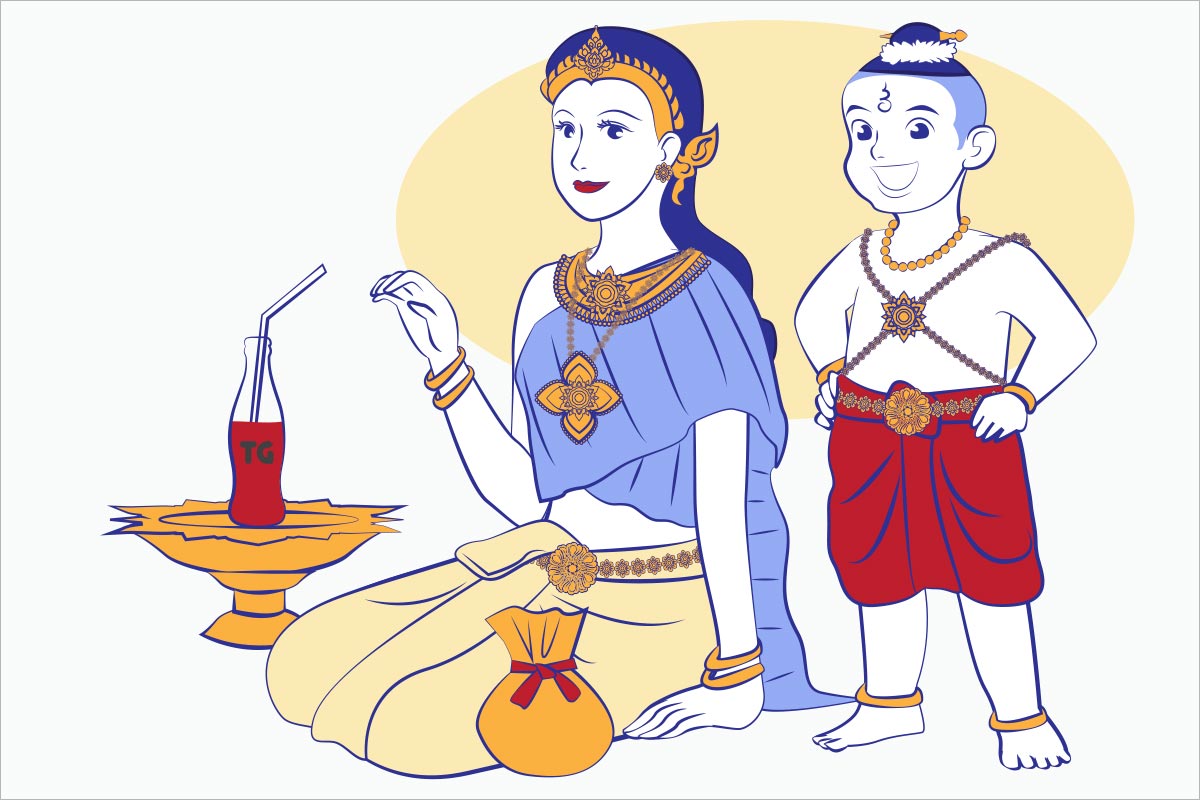If you have seen some of the famous Thai movies like ‘Pee Mak’ or ‘The Medium,’ you will know that Thai people have a superstitious culture. Most of their superstitions stem from their religious beliefs. And one of the most commonly accepted superstitions is carrying amulets for various purposes.
Curious to learn more about Thai amulets?
This is your complete Thai amulet guide – covering their history, how they are made, and why they are worn in Thailand. Plus, if you’re an aspiring collector, you’ll find a list of the most famous Thai amulets and advice on where to get them. Let’s start with the basics:
What is an amulet?
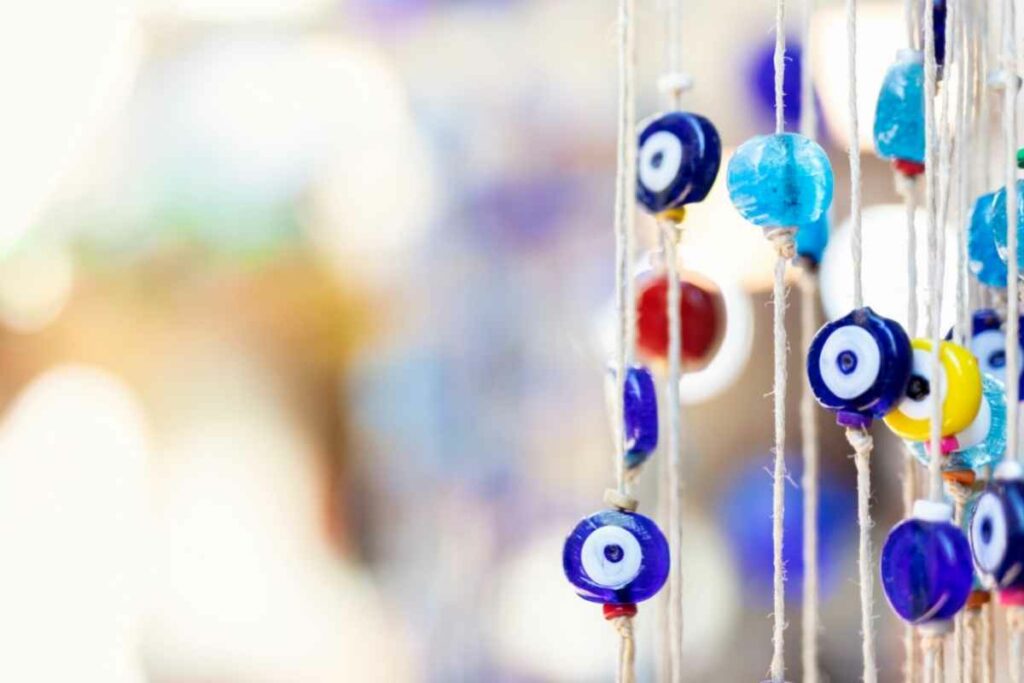
An amulet is defined as an object believed to be “endowed with special powers to protect or bring good fortune. It is also defined as a charm or ornament often inscribed with a symbol or magic incantation to “aid the wearer or protect against evil.”
Among believers, amulets are viewed as deriving power from religious associations, connection with natural forces, or from being made for ritual purposes. They can be natural or man-made.
Amulets are carried on the person or stored in the desired place – such as in the house or on the roof.
There are many kinds of amulets.
Natural amulets can be a number of things. Such as precious stones, teeth, claws of animals, bones, and metals. Plants like four-leaf clovers can also be a natural amulet, as it is believed to bring good luck. As for man-made charms, they can be in the form of small figurines, religious medallions, or jewelry. (Source, Source)
Whatsmore, different countries have their own versions of amulets.
For instance, “evil eye” amulets (which usually have the shape of an eye inside a circle) are of popular belief in the Middle East. Whereas natural amulets like “crocodile teeth” are considered by some African people to help them win gambling. (Source)
History of Thai amulets
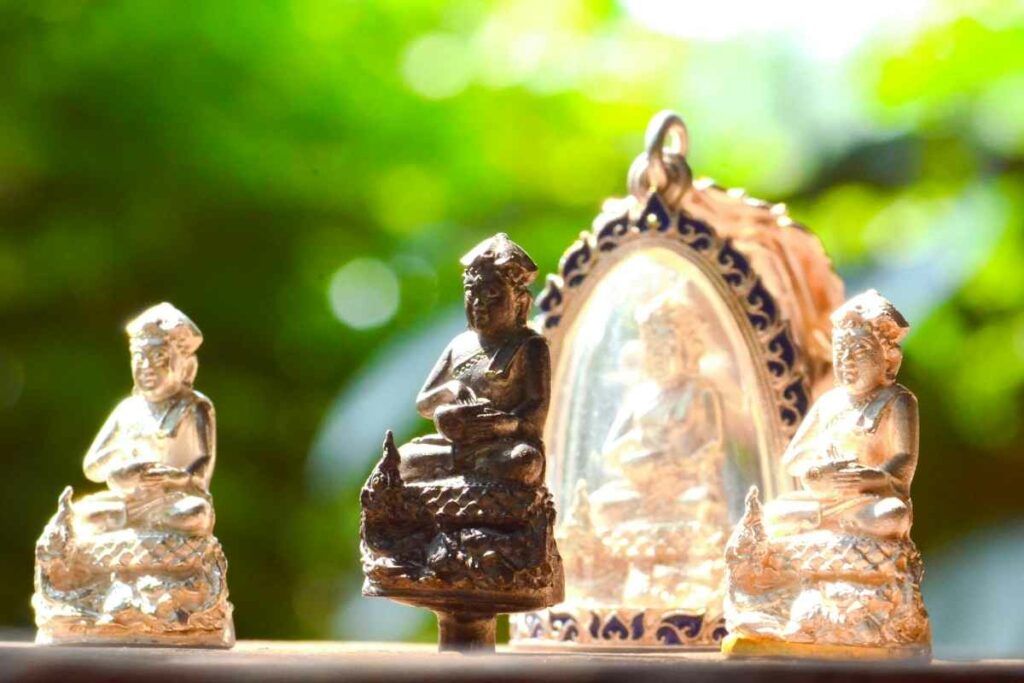
In ancient Buddhism, making symbolic religious objects was not commonly practiced.
It is argued that Thai amulets were first designed after the style of Greek amulets and icons of deities distributed widely under the rule of Greek King Menander in India.
When Buddhism reached Thailand, people started to worship the religion. This, in return, influenced the creation of Thai ‘Pra Kruang.’ Amulets were made to serve as an object of worship for the followers of the belief.
The emergence of authentic Buddhist amulets in Thailand during the late 19th century – displayed the cultural shift in Buddhism’s role in the country’s society. This was due to Bangkok’s Thai elite members championing philosophies related to humanism and individualism.
Consequently, their approach to religion had shifted. Rather than focusing on solely on spiritual matters, they considered realities of the physical world and pursuing material happiness.
These modern values indirectly caused the belief in the supernatural powers of amulets to be reinforced in Thai society. Local people began to view the Buddha and his devotees as saviors who could bring good fortune to the worshippers.
Hence, prominent monks in the country began to produce amulets of their own for the believers.
Since then, Buddhist amulets in Thailand have been widely found across the country. It is difficult to pinpoint the exact origins of Thai amulets. But it is a reasonable theory that they were first created in Thailand when Buddhism began to flourish. (Source, Source)
How are Thai amulets made?
It is believed that the very first Thai amulets were made of simple, locally sourced materials. Local people utilized a group of plants (known as ‘wan’), which were seen as medicinal and had the power to protect against vulnerabilities.
As Buddhism and Hindu-Brahmanism grew over time (in what is now Thailand), amulet productions became more sophisticated.
Amulets can be made in a variety of methods. The most common ones are those manufactured from a mixture of different ingredients – pressed in a mold and baked.
Some are made with powders mixed with oils or herbs and then pressed into a pre-designed metal plate to create different shapes and sizes. These amulets are then baked at high temperatures to solidify them. Some amulets are made from metal or a mixture of metal and other ingredients. These mixtures are melted down at high temperatures and then poured into a mold to set.
The ingredients included in amulets are often kept as secrets by the monks or people who make them –depending on the final use. The finished amulets are then blessed by monks, priests, or learned laymen upon creation.
Amulets are often inscribed with the mark of the temple or the monk who produced them. Cryptic and sacred diagrams composed of graphic symbols (known as ‘yantra’) are often found on the amulets.
It is believed to increase their power. Some even add gold or precious stones to the backs of charms.
Aside from these man-made amulets, many amulets found in Thailand’s rural areas are often made from natural materials. Wood, flowers, stones, and even earth and clay are used.
People in such places tend to use ingredients that are readily available in the area they live in. Old metal amulets and powered ones are often used in creating new amulets. It is believed that this will transfer some of the ancient, powerful magic to the new amulets. Thus, making them more potent for the wearer.
Ingredients are not the only important aspect of creating amulets.
For an amulet to be “powerful”, it must be crafted and blessed by monks or people that are highly skilled and experienced. That is why some amulets are created by many monks praying together. This blesses the amulets with particular powers. Whatsmore, only the experienced spell casters among them are allowed to do such work.
At the beginning of those ceremonies, all people involved must be cleansed. This is to show recognition and respect to the previous monks who were involved with these particular amulets. Also, in recognition of the spirits that are going to be associated with bringing blessings or supernatural powers to the amulets. (Source, Source)
Such processes are considered sacred and must be done with great reverence from everyone involved.
For more explanation of the history of Thai amulets and how they are made, here is an informative video:
Why do Thai people wear amulets?
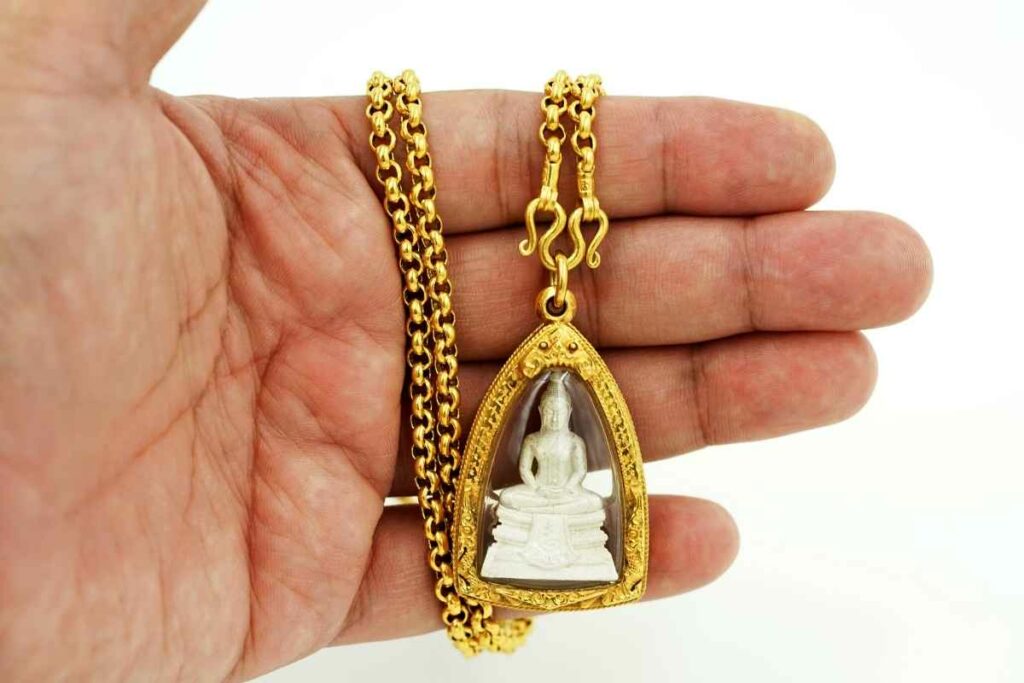
Although amulets are common superstitions among many cultures, people wear different amulets for a specific purpose.
The religious significance of different amulets can vary from user to user. Also, what they represent can be connected to a certain moment in their life.
For example, a rabbit’s foot is a popular amulet in the U.S. According to ancient Celts’ belief, rabbits could directly communicate with gods and spirits.
In Norse legend, the oak tree represents the god of thunder and lightning. Thor and ancient Norse filled their houses with acorns to protect against the lightning.
In Thailand, it is the same.
People wear or carry the amulets for various purposes. The most common belief about amulets in Thailand is that they can provide the carrier with good luck. Also, that they protect against any kind of misfortunes in their lives.
Thai people usually wear amulet necklaces as a way to protect themselves against disease, accidents, and witchcraft. It is also believed that the older the amulet is, the stronger the protective power.
It is suggested that three different types of people collect amulets – the wealthy, the traders, and the believers. Each of these groups has a different purpose:
- Wealthy people: wear amulets around their necks as a sign of prosperity.
- Traders: collect amulets for financial gain and profits.
- Believers: wear amulets purely for luck (as stated above).
Amulets in Thailand are also worn to get closer to the Lord Buddha, especially if worn around the collector’s neck.
Even though the teachings of Buddha do not actually encourage the usage of amulets, many Buddhists in Thailand surround themselves with as much protection and luck as possible. Therefore, carrying, wearing, or at least keeping the amulet at home or workplace.
They believe that wearing amulets brings them closer to Lord Buddha and will remind them about things to do and things not to do. These amulets often have the form of miniature Buddha statues or representations of different holy monks.
No matter what the reason is for wearing or collecting amulets, it can be generally considered that Thai people wear amulets as a way to get clarity and peace of mind. (Source, Source)
10 Most famous & powerful types of Thai amulets
Popular Thai Buddha Amulets (Phra Khrueang)
Usually, in the form of small Buddha images, Phra Khrueang or Thai Buddha amulets can have the appearance of monks, the Bodhisattvas, maestros, and other gods. Thai people believe that these amulets will protect them against danger, bring them good fortune and, to some extent, make them invincible.
These amulets are small enough to be manufactured in large quantities as miniature replicas of the image of Lord Buddha.
In ancient times, Thai warriors carried these amulets with them. As of now, these amulets can be seen being worn around people’s necks as lucky charms.
Below are some of the most well-known Buddha amulets worn or kept by Thai people:
1. Jatukham Ramthep
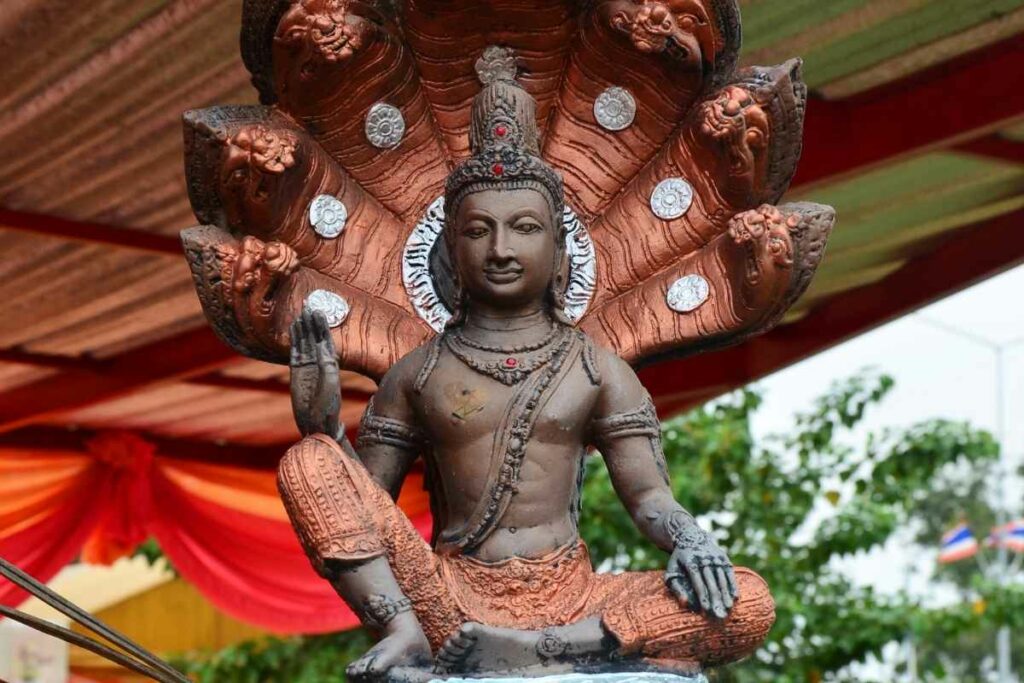
Known as the most popular Thai amulet at the beginning of 2007, Jatukham Ramthep [จตุคามรามเทพ] is an amulet depicting the image of two gods – Thao Khattukham and Thao Ramthep, who guard the Wat Phra Mahathat Woramahawihan temple located in Nakhon Si Thammarat.
Both gods are believed as supreme deities according to Brahmanism beliefs:
Jathukham is a name for the creator god Brahma and Rammathep (being the name for Lord Rama), the avatar of Vishnu, the god. Later, they were renamed Thao Jatukham.
There is also another belief that stemmed from the local legend in southern Thailand. According to that belief, Jatukham Ramathep was a king of the Nakhon Si Thammarat Kingdom that existed around AD 1287.
This monarch and the mighty warrior was named “the Black King of the Southern Seas” once he had succeeded in establishing the Srivijaya Kingdom.
In 2007, the country went into the “Jatukham craze.”
Jatukham amulets were believed to have the ability to make their owners ‘super rich’ or wealthy without any reason. The craze for Jatukham amulets was so extreme that in the early stages, a local woman was crushed to death in a crowd at a Nakhon Si Thammarat temple while trying to place amulet orders.
Due to this frenzy, the price for the first Jatukham amulet made in 1987 skyrocketed to over a whopping 40 million THB (over 1 million USD). The original price was only 49 THB (a little over a dollar).
Incredible.
Other variations of Jatukham amulets were also sold at high prices. A top-of-the-range, gold-leaf edition from a famous temple was purchased for more than 10,000 THB (280 USD). Jatukam owners would proudly display their amulets. Either on the outside of their shirts or suspended from a thick gold chain.
It was highly believed that Jatukam supports the owner, offering strength, clarity of thought, and enhancement to their lives. (Source, Source)
2. Phra Somdej
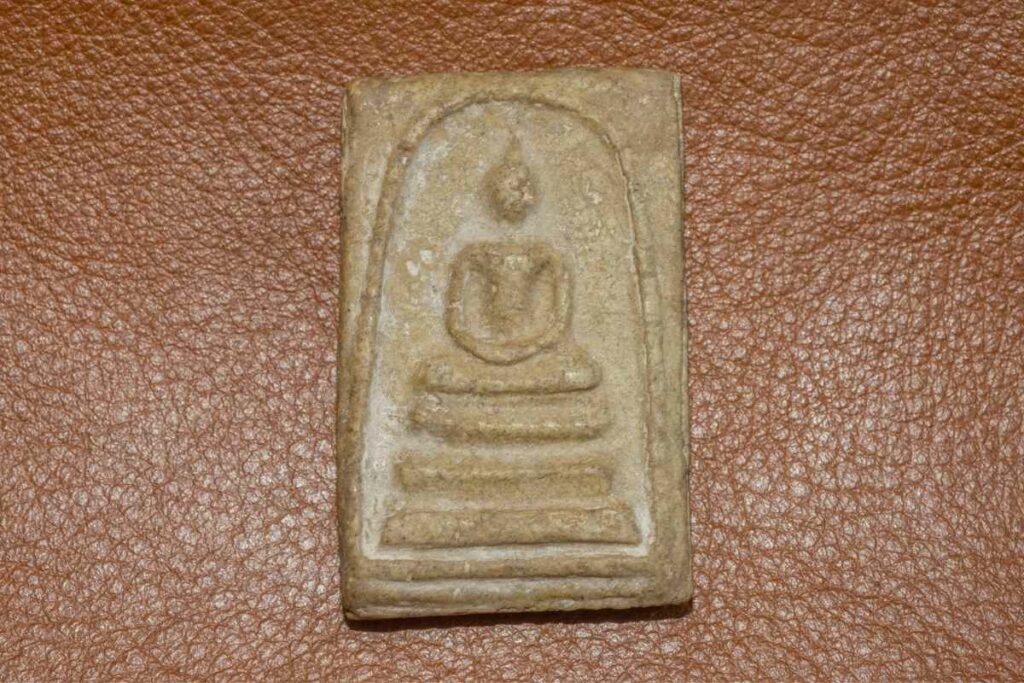
Considered one of the most powerful Buddha amulets around, Phra Somdej is also known as the ‘King of Amulets’. This is because it was intended to bring the highest praise and blessings of Lord Buddha to the wearer.
The amulet was named after its maker – Somdej Phra Buddhacara Toh Prommarangsi. A famous monk and son of King Rama II who is known to be compassionate, morally upright, and very dedicated to his faith.
There are many prints of Phra Somdej, but the most popular one seems to be Phra Somdej Rahkhang. An original piece of the amulet dating back to the 19th century can cost anywhere from 80 million to 150 million THB (2.2 million to 4.2 million USD).
Phra Somdej amulets feature the image of a faceless Lord Buddha sitting on three platforms that symbolize the three cosmology levels in Buddhism. (Source)
3. Phra Nang Phaya
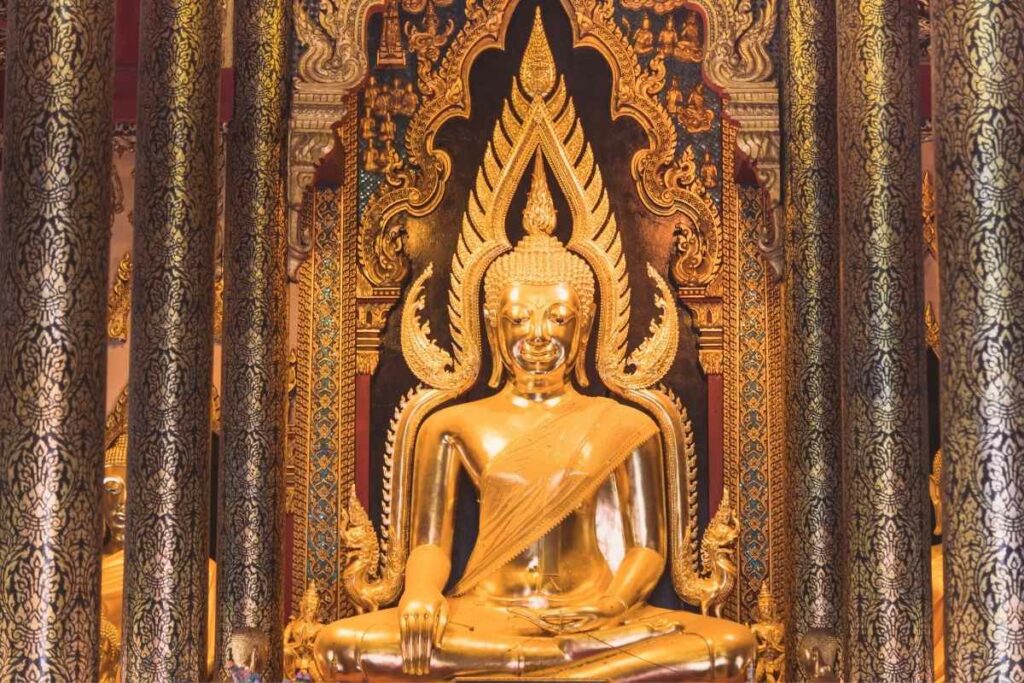
The Phra Nang Phaya amulet was found at Wat Nang Phaya, a temple dedicated to King Narasuan’s queen.
Honored as the “Queen of Amulets”, the amulet was said to be first discovered in 2444 B.C.E.
These amulets are made with holy water, golden and silver sand metal, sacred soil, nam phee, a unique iron mineral, and holy relics.
It is believed that Phra Nang Phaya amulets bring good fortune and protection. During ancient times, these amulets were given to troops of King Naresuan that were yet to win a battle and were afraid of foreign invasions. (Source)
4. Phra Kring Pawareth (Ringing Amulet)
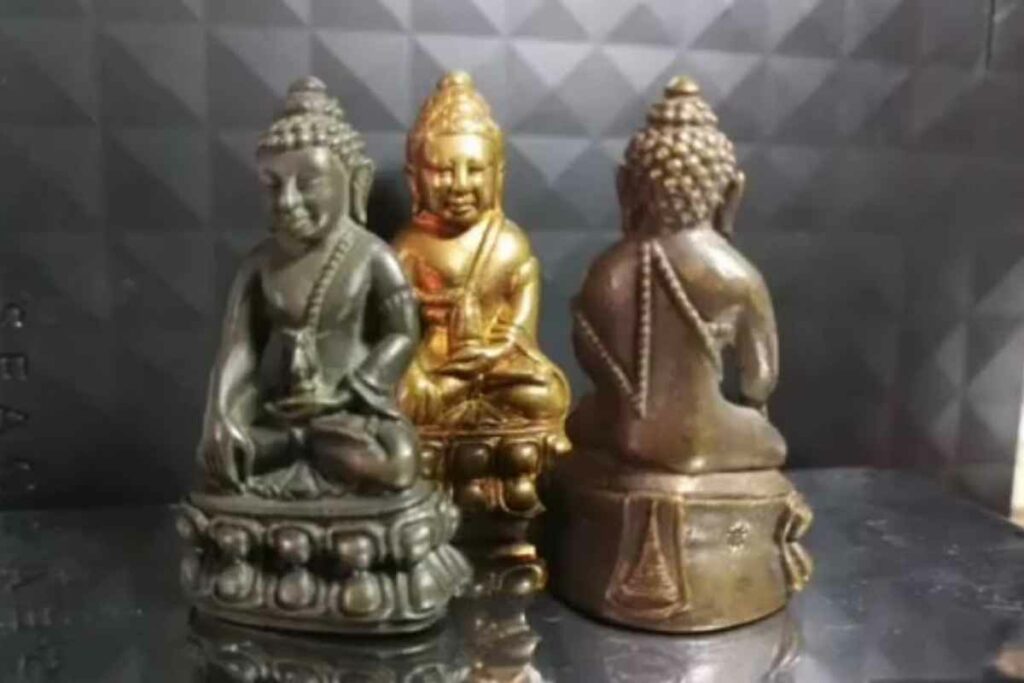
Phra King Pawareth is also known as the “Ringing Buddha.” It was first produced in 2390 B.C.E., during King Rama III’s reign.
This amulet was made in the image of the Mahayana Medicine Buddha. It is believed that whoever worships the Mahayana Medicine Buddha will be blessed with a long and healthy life and safeguarded from harm.
Therefore, these ringing amulets are believed to help cure illnesses and diseases of their keepers. They remind
As there are many Thai people (and foreigners) who are health-conscious, Phra Kring Pawareth amulets tend to be sold out quickly. After all, who wouldn’t want a reminder and protector of their well-being? (Source)
5. Phra Pid Tha
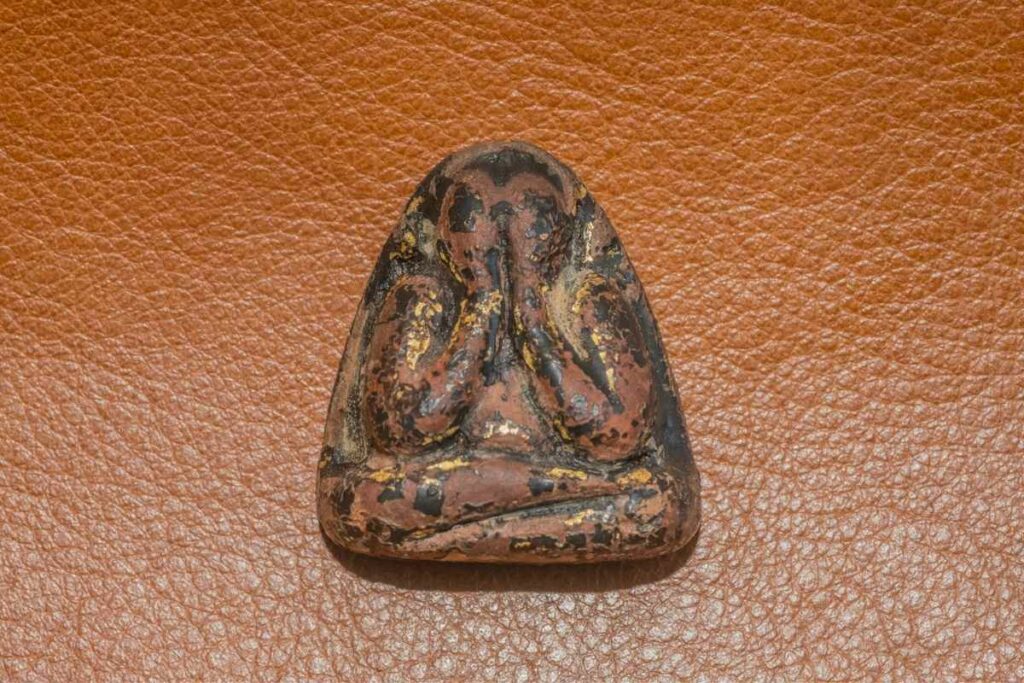
In the Thai language, Phra Pid Tha means ‘monk who is covering their eyes.’ These amulets were first discovered in 1850.
As the name of this amulet suggests, the image of the monk with closed eyes depicts going into Nirodha (“cessation”). This is a state of immunity from the sufferings of life – a removal of thinking.
The amulet is popular among people looking to improve their luck and mindfulness. As the closed eyes monk represents being invisible from the distractions and danger of life.
Therefore, shielding the wearer from suffering and dissipating their negative thoughts.
The amulet is also associated with charm and financial success. This explains why it is one of the most sought-after Buddha amulets in Thailand. (Source)
Other types of amulets in Thailand
Aside from the Buddha amulets, other types of amulets can also be found in Thailand.
Below are the examples of some amulets local people believe in:
6. Kuman Thong (The Golden Child):
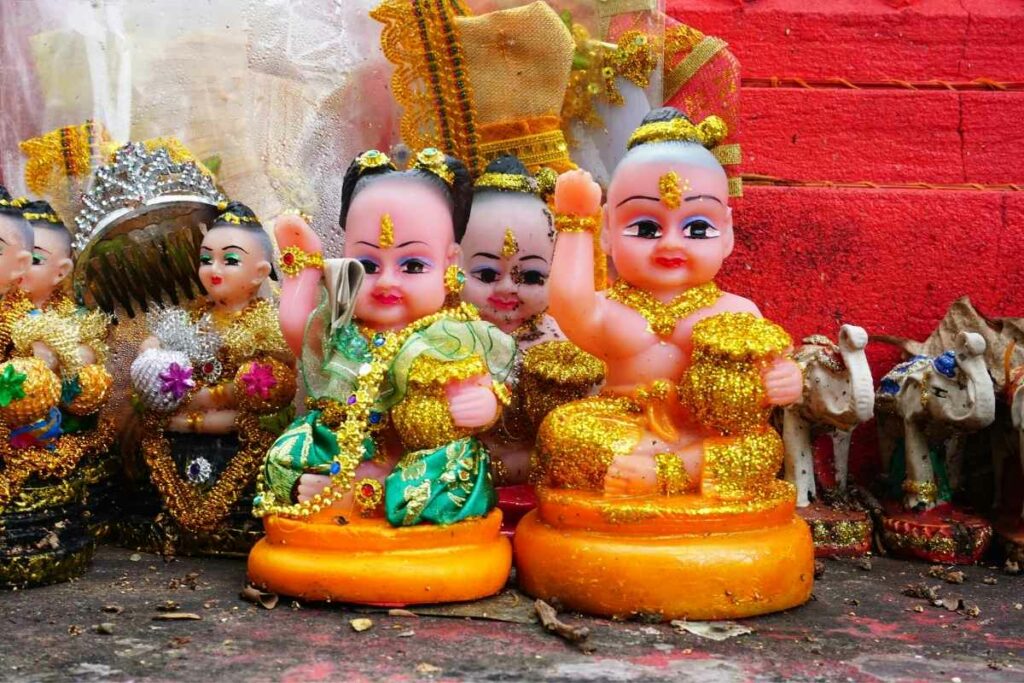
While visiting Thailand, you might see a child figure placed on top of the shelf at a local grocery shop. (Especially in the rural areas.)
That figure is not just any figure – it’s an amulet for luck.
Known as Kuman Thong (กุมารทอง), kuman means sanctified or holy young boy, and thong means golden. Therefore, these amulets are effigies of little boys with covered in gold.
Traditionally, the Kuman Thong was a stillborn baby boy that had died in the womb of his mother. The fetus was roasted to a dried-out husk while being chanted over. Then covered in lacquer and gold leaf.
It is believed to represent the spirit of a child, and honoring the spirit of the effigy will bring good fortune. The spirit of a child is called upon and invited to live in the statue. As spooky as it sounds, many people keep Kuman Thong statues. They believe that it protects them from disasters, helps identify enemies, and boosts prosperity.
One condition that every Kuman Thong keeper must follow is that the amulet should be taken care of as if it were a real baby boy. The keepers must feed the figure and invite him to join the table. (Source)
Nowadays, it does not require a tragic event to create a Kuman Thong figure. Using human remains for ceremonies is illegal. It can be made from either the soil collected from seven cemeteries, gooseberry wood, milkweeds, or metals. These ingredients are then shaped into the form of a boy dressed in Chong Kraben clothing and with a topknot hairstyle.
However, it is suggested the practice of using body parts to make them continues on the black market. CNN and New York Post reported in 2012 that Bangkok police arrested a Taiwanese man who possessed six fetuses that had been roasted and covered in gold leaf. (Source, Source)
7. Nang Kwak (Goddess of Fortune):
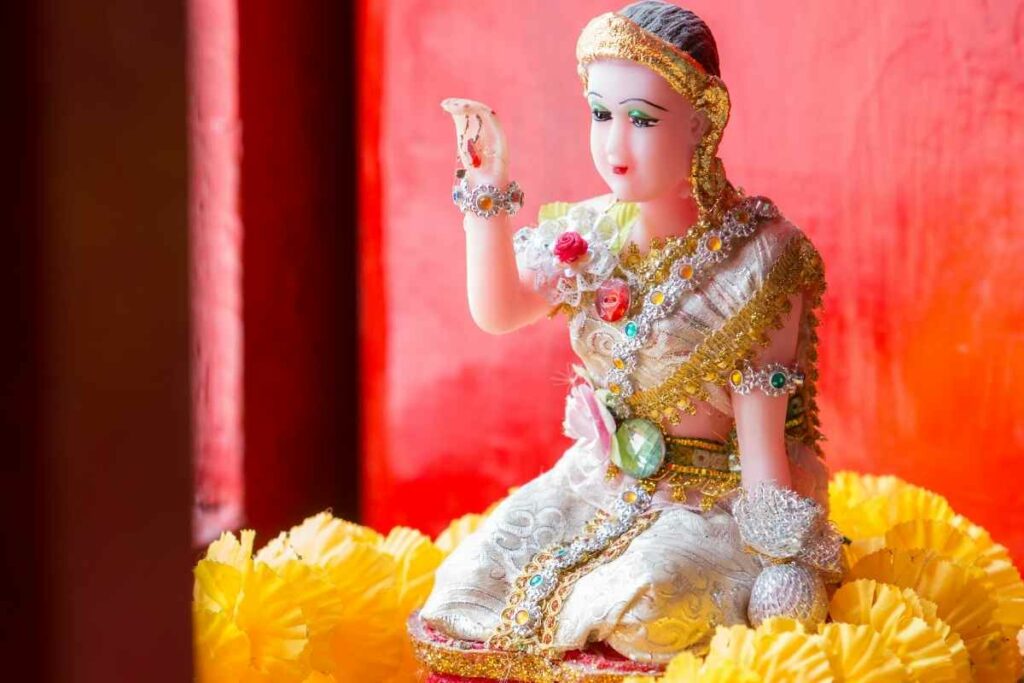
Another common amulet present in Thailand is Nang Kwak (นางกวัก) – the goddess of fortune statue.
The statue features a woman in a traditional Thai costume with accessories. She is sitting on the floor with her legs folded to one side. Her left hand is placed either on the side or on her lap, while the right hand is raised to shoulder level in a beckoning gesture.
People believed that this inviting hand signal would “beckon wealth and customers” to the business.
For that reason, Nang Kwak statues are considered as Thai amulets for wealth. And can be seen at many business establishments across the country.
The Nang Kwak statues were first discovered in Thailand during the Ayutthaya period (AD 1350- 1767). Later in the modern eras, the worship of Nang Kwak became more popularized during the reigns of King Rama IV and V. This was due to the economic developments in those eras.
Interestingly, it was also around the time that the famous ‘Maneki-Neko’ (or beckoning cat of Japan) made its first appearance in the country. This solidified Thai people’s beliefs in such “luck beckoning statues”. (Source)
8. In Koo (Love Charm):
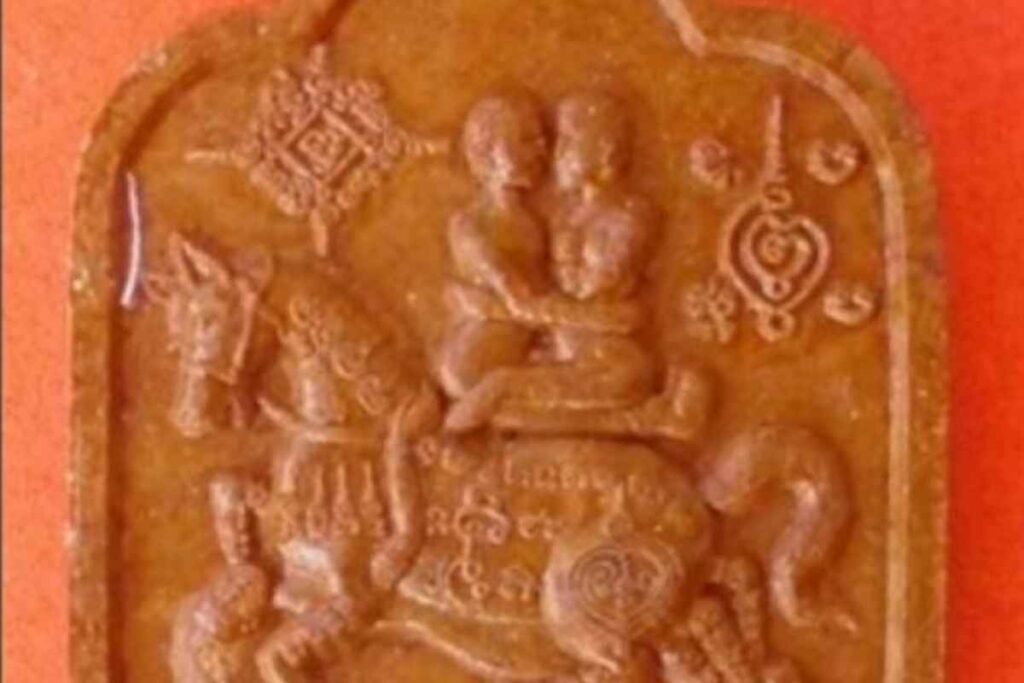
The In Koo (also known as “Yin Ton” in South East Asia) can possibly be considered the most powerful Thai love amulet.
This extremely popular symbiotic deity represents a woman and a man embracing each other.
Ancient people believed it signifies the first ever pair of male and female in the history of humans. Thus, a symbol of love between woman and man.
As such, it is believed the keepers of an In Koo charm would be blessed with Maha Sanaeh power over the opposite sex. This will make the opposite sex feel attracted to and want to get to know the holder.
When kept in the home, the In Koo will help all the people in the household to love one another. And be happy together with their family members.
Suppose it is worn or carried on one’s body as a Thai love charm amulet.
In this scenario, it is believed to make everyone that the wearer comes into contact with to be friendly and compassionate towards them. Whatsmore that it can make others fall in love with him or her.
Aside from being a powerful love amulet, the In Koo is also believed to make businesses flourish, attract money and gifts, and make life less bothersome.
This charm has been used for thousands of years by ancient folks and shows no signs of losing its popularity anytime soon. (Source)
9. Thai Lizard Amulet (Jing Jok):

The “Jing Jok” (or the Gecko) is a magic animal that has appeared in Thai folklore since the pre-Buddhist eras of Animism. It usually comes in the form of the lizard statue put in a clear amulet case.
According to Thai mythical beliefs, you will be blessed with lucky windfalls and other favorable events if you hear a Gecko’s greetings while leaving your house.
The Thai lizard amulet is famous among perpetual gamblers and businessmen. It is believed to increase gambling fortunes and improve business talks and sales.
The Jing Jok is also said to be powerfully endowed with Kong Grapan Magic. This protects the wearer from harmful accidents and deadly attacks. Its perceived anti-black magic properties also keep curses away.
It is also a popular Thai amulet for love – a favorite love charm of many generations in Thailand. (Source)
10. Thai Elephant God Amulet:
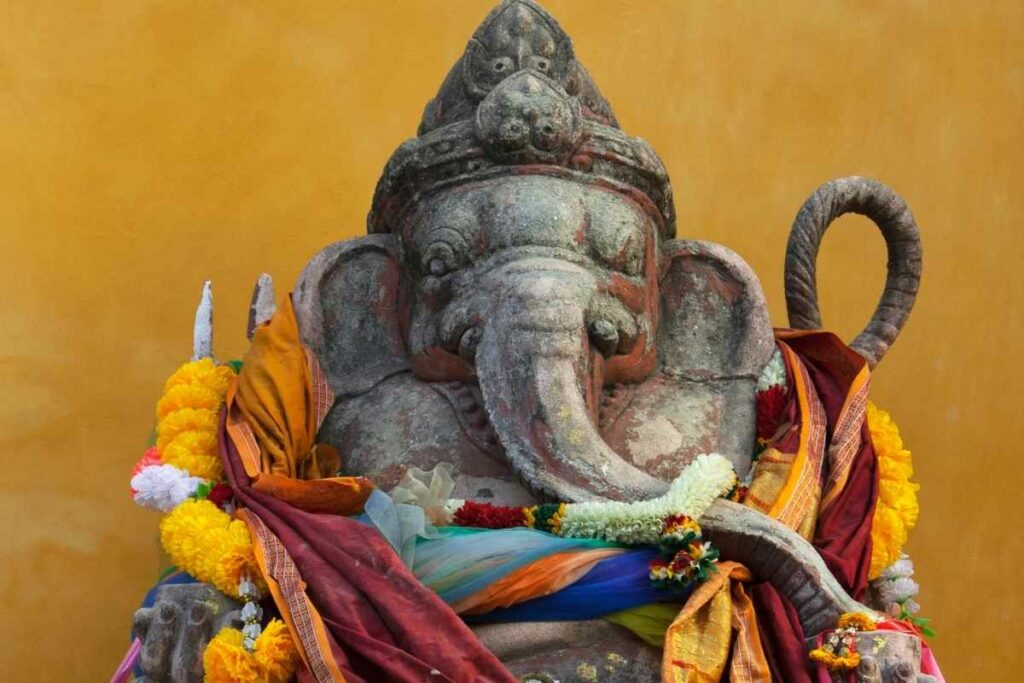
The Hindu deity Ganesha is known as Phra Pikanet in Thailand. It is one of the most worshipped deities in Asia. Son of Shiva and Parvati, Phra Pikanet is the Hinda god who governs the mother earth and life force. His image can be found throughout Asia in many variations.
Still, the elephant head makes him easy to be identified. There are versions of him being portrayed as sitting, standing, dancing, or playing. Whatsmore, Phra Pikanet usually has four or eight arms and is holding various objects. All items and traits contain interesting symbolisms to remind his devotees.
These characteristics and traits are believe to represent the following:
- A big head to think big.
- Large ears and small mouth to listen more and talk less.
- Small eyes to focus.
- A large stomach to take in all the good and bad things happening in life.
As for the objects:
- The axe is for cutting all bonds from worldly attachments.
- The mouse represents keeping all desire under one’s control.
- The rope to bring the devotees to their nearest goals.
- The broken tusk signifies sacrifice.
These Phra Pikanet amulets are believed to protect the keepers against evil and weapons. They are bring an abundance of wealth as a result of thriving trades. It also is believed to have a subtle charm that can attract the opposite sex.
A fantastic gift idea to give to someone special or an amulet collector. (Source)
Where to get yourself a Thai amulet
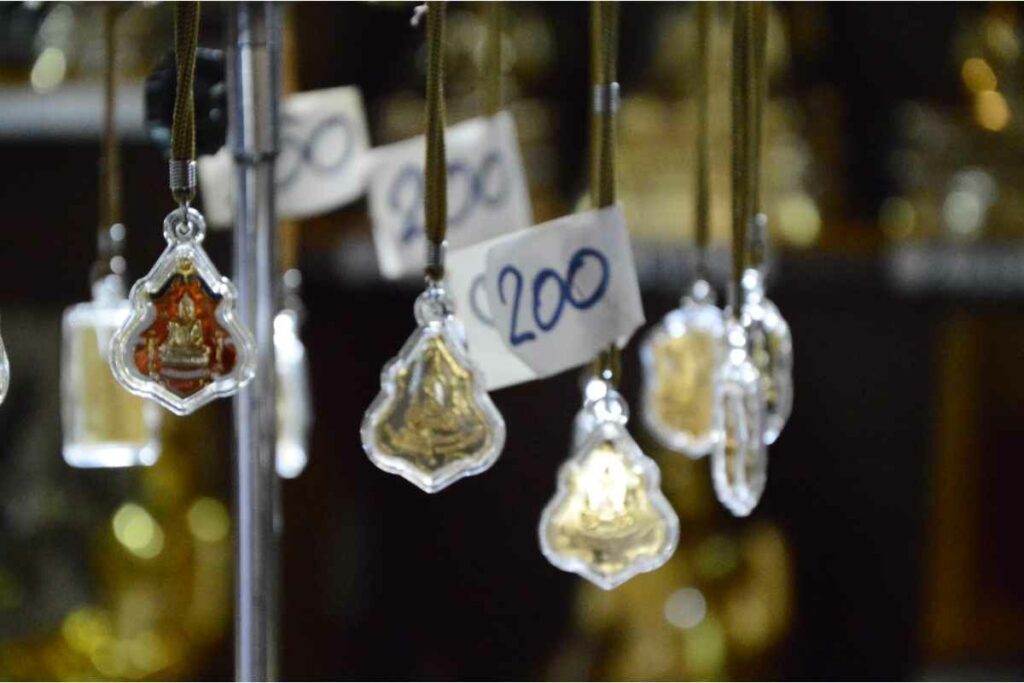
The Thai amulet industry is huge. It can be found online and offline across the country.
Before going to get yourself one, here’s one thing you should know:
Most, if not all, local people tend to refer to collecting amulets as ‘borrowing amulets’ rather than ‘purchasing amulets’. This is because the trade or sale of Buddha imagery for money is considered offensive and superficial to Buddhist traditions.
Temples for Buddhist amulets
Sacred Buddhist amulets are crafted only at Buddhist temples.
So, the best place to get one of the Buddhist amulets – and have it blessed by monks for extra powerful effects – is at one of the Buddhist temples in Thailand.
Also, by getting one directly at a Buddhist temple, you can be sure that they your new amulet is geniune.
As you would expect, Buddhist temples and monks would not go against the principles of Buddha and get involved with fake amulets. They only sell amulets they have manufactured or that have been commissioned the approved Buddhist craftsmen.
Grand Palace Temple, Wat Phraw Kaew, Wat Pho, and Wat Arun would be the best temples to visit and get your Buddhist amulets in Bangkok.
Markets for Non-Buddhist amulets
Looking for local markets to get non-Buddhist amulets? Or for cheaper alternatives of the famous amulets for sale in Thailand?
Talaad Phra Chan (Sunday Amulet Market):
In that case, Bangkok’s Sunday Amulet Market – Talaad Phra Chan is an amulet collector’s heaven.
This location is known to have the most comprehensive selection by far in Bangkok. It’s usually filled with hundreds of stalls selling all sorts of amulets and pendants – metal, clay, wooden, ivory, tooth, and many others.
Located on the Chao Phraya River (adjacent to Grand Palace Temple and the Thammasart University), the market is open every day except on royal holidays. The vendors are more active on the weekends. (Source, Source)
Thai amulet price
As for the price of a Thai amulet, it depends on how rare or how antique it is. Artificial amulets you can find at markets might cost as low as 20 THB (50 cents). While extremely rare Thai amulets are priced at millions.
The most expensive Thai amulet ever sold (Luang Puu Kai Amulet from Cherng Lane temple) holds a record of 30 million THB (845,000 USD) per amulet.
▸ READ MORE about ▸ Thai Traditions
Grab yourself a new amulet.
Has this guide ignited (or reignited) your passion for Thai amulet collecting?
Now that your curiosity has been solved, it’s time to book your ticket to Thailand and grab yourself one (or several).
Now before you do, keep in mind these three behaviors to follow while wearing your new amulet:
- Do not insult someone’s mother.
- Do not have an affair.
- Do not wear an amulet on your body while having sexual intercourse or visiting a brothel.
You’ll certainly not want to land yourself in any trouble with the deities.
Knowing how to take care of your amulets will maintain their power – ensuring you are blessed with the maximum of good fortune!
Like always, if you want to discover more about Thailand, stay guided by ThaiGuider. You might learn something you never knew about this unique country.
▸ CHECK OUT our Complete Guide on ▸ Thai Culture
THINKING ABOUT A TRIP TO THAILAND?
I am working on a FREE Thailand Travel Guide with a FULL 7 Day Itinerary. Be the first to receive it!
Thank you for signing up.
Something went wrong.
